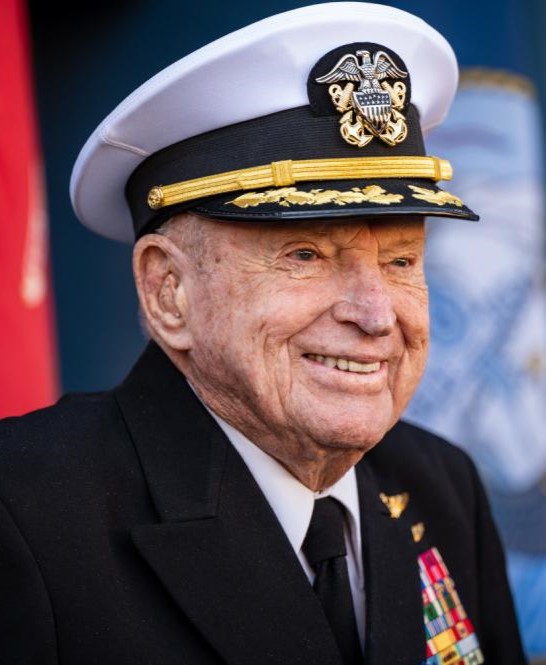WILLIAMS-ELMER
ELMER "ROYCE" WILLIAMS

CAPT

DOWNED FOUR SOVIET MIGS IN SINGLE 1952 ACTION
Elmer Royce Williams joined the Navy in August 1943 as an aviation cadet and became a Naval Aviator by the end of World War II. He also served in the Korean and Vietnam Wars, flying over 220 combat missions before his retirement in 1975 as a Captain.
Williams is best known for his action on November 18, 1952, when he participated in a 35-minute dogfight against seven Soviet MIG-15s. He was serving off Korea aboard the carrier USS Oriskany when an NSA team aboard the cruiser USS Helena reported a flight of Soviet MIGs had departed Vladivostok and were apparently headed toward Oriskany in possible retaliation for a U.S. strike against a North Korean target near the Soviet border. Williams piloted a F9F-5 Panther fighter which departed Oriskany with two other F9Fs to meet the MIGs. On intercepting the MIGs, Williams was soon engaged in combat with seven MIGS and has said his F9F was vastly inferior to the MIGs in speed, maneuverability, acceleration, and firepower, and the only thing he could do was out-turn them. Williams said he fired at every MIG that passed within gun range as they came by, and he spent not a second on straight and level flight.
In a later interview Williams said: “I went after the section leader. He pulled up into the sun and I lost him, then I saw the leader and his wingman come around for a diving attack. I turned into them and fired at the leader. He turned away and the wingman rolled down on me and we went past belly-to-belly as I raked him with a long burst. He caught fire and went down. The section leader then came around and I turned into him and fired at him practically point blank and he went down. The leader then came around again and I fired, and parts came off him as he dove away. I maneuvered to avoid the wreckage and I porpoised to try and clear my tail. I was tracking another wounded MIG when I suddenly spotted one of the other two as he slid in on my six. He fired a burst with his cannon and hit me in the wing. The shell went into the engine area and messed up the hydraulic unit in the accessory section. I suddenly lost rudder and flaps, and only had partial aileron control. The only thing that really worked were the elevators. I dove toward the cloud deck below at 13,000 feet, and he was 500 feet behind me and still shooting all the way down. It seemed like it was taking forever to drop that 10,000 feet! My wingman finally got back in the fight and came in on the MiG and he pulled away as I went into the clouds.”
When the battle was over Williams fought to control the F9F and soon discovered it was uncontrollable below 170 knots. Arriving back to Oriskany the ship’s stern rose and fell through a 20-foot arc but with help from the Landing Signal Officer he successfully caught the three-wire upon landing, well above the normal landing speed of 105-knots. The crew counted 263 holes in the aircraft and because of the extensive damage it was pushed over the side into the sea. During the engagement Williams fired all 760 rounds of 20mm shells on board his plane.
The NSA team reported they had proof from recorded radio transmissions that Williams had shot down at least three of the MIGs. Following the battle, Williams was personally interviewed by several high-ranking Navy admirals, the Secretary of Defense, and also the President, after which he was instructed to not talk about his engagement as officials feared the incident might cause a devastating increase of tensions between the U.S. and Soviet Union, and possibly ignite World War Three. Accordingly, Williams actions were unknown until it was declassified 50-years later. and the Russians also opened their records and revealed that Williams had indeed shot down four MIGs. Williams accomplished what no other American fighter pilot has ever accomplished: shoot down four MIGs in one fight, a truly remarkable feat.
In 1953, Williams was presented the Silver Star Medal in recognition of his actions. Williams became the top-scoring carrier based naval aviator and the top scoring naval aviator in a Navy jet of the Korean War. In spite of appeals to issue Williams an award more appropriate for what he had done, the Navy refused for many years to do so on grounds that there is no longer an American witness alive to verify Williams account.
After a years-long campaign, on July 14, 2022, a bipartisan group of five congress members persuaded the House of Representatives to approve an amendment to the Defense Authorization Act which would properly award Williams the medal he merited for the feat he accomplished. On January 20, 2023, at the San Diego Air & Space Museum before an audience that included a U.S. Supreme Court Justice, the Secretary of the Navy Carlos Del Toro presented the Navy Cross to Retired Captain Williams (age 97) as an upgrade of the Silver Medal he was awarded in 1953. Secretary Del Toro said, “Having reviewed the findings of now numerous investigations related to the case of Captain Williams, I have determined this case to be special and extraordinary. His actions clearly distinguished himself during a high-risk mission and deserve proper recognition.”
LT Williams poses with his severely damaged F9F-5 Panther after his engagement with seven Soviet MiG-15s on 18 November 1952.
Submitted by CDR Roy A. Mosteller, USNR (Ret)

